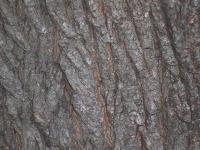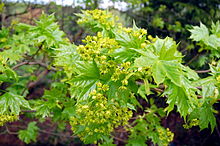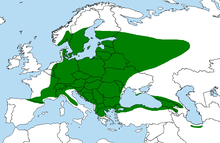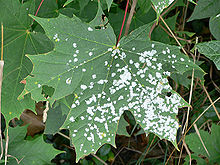Norway maple
| Norway maple | ||||||||||||
|---|---|---|---|---|---|---|---|---|---|---|---|---|

Norway maple ( Acer platanoides ) |
||||||||||||
| Systematics | ||||||||||||
|
||||||||||||
| Scientific name | ||||||||||||
| Acer platanoides | ||||||||||||
| L. |
The maple ( Acer platanoides ), also Spitzblättriger maple called, is a plant from the genus of maple ( Acer ) within the family of the soap tree plants (Sapindaceae) or maple plants (Aceraceae). To emphasize its membership of the maple genus, the hyphen spelling of Norway maple is common in botany .
The Norway maple is one of the most common trees in German cities and villages and is particularly noticeable at the beginning of spring when a large number of yellow-green flower umbels bathe streets, avenues and parks in a fresh, light green before the dark leaves shoot , while many other trees are still largely bare .
Common names
Other common names for the Norway maple that are no longer used today are Lehne, Lenne, Löhne, Leinbaum, Leimbaum, Linbaum (Saxony), Leinahre (Switzerland), Breitlaub, Breitblatt, Breitlöber, Weinblatt or Gänsebaum. In addition, the following names exist or existed: Norwegian maple ( Swabia ), Polish maple (Swabia), Pomeranian maple ( Silesia ), Spitziger Ahorn, Bergahorn (Swabia), Breitlaube (Mark near Luckau), Breitleben, Breitlehne (Silesia), Epeler , Flaschebaum ( Transylvania near Schässburg ), Gänsefussbaum, Gänssbaum, Lähn ( Mecklenburg ), Laön ( Altmark ), Leimahorn ( Bavaria ), Leime, Leinöhre (Swabia), Lie ( Glarus ), Lienahorn ( Berchtesgaden ), Lienbaum (Swabia), Line , Löhn ( Pomerania ), Löne, Lömme, Lön, Lönne, Lon ( Lower Saxony ), Great milk maple (Swabia), milk tree, Sallat tree, Spitzflader (Silesia), stone maple, Waldéscher, water tree ( Austria on the Traun River), Weissbaum ( Swabian Alb ) Grape leaf, Welsche, Wittléne and sugar maple .
Description and ecology
Appearance and leaf
The Norway maple is a deciduous tree that reaches an average height of 20 to 30 meters and is therefore not as high as the sycamore maple ( Acer pseudoplatanus ). It can live for about 150 to a maximum of 200 years. Its bark is smooth and pale brown when young; in old age the bark is dark brown or gray; the structure is longitudinally fissured and not scaly. If the leaves or young twigs are damaged, milky sap emerges.
The constantly against arranged on the branches leaves are divided into petiole and leaf blade. The leaf blade is palmate, five-lobed with long, pointed, entire lobes. The bays between the leaf lobes are always blunt.
Inflorescence, flower and fruit
The flowers are similar to the field maple and stand in upright, umbelliferous inflorescences . There are both hermaphroditic and unisexual female and male inflorescences. Often - but not always - the genders are distributed among different individuals - the gender distribution is therefore incompletely dioecious. The flowering period is from April to May and begins before the leaves appear. The pollination is done by bees , bumblebees and other insects.
The fruits of the Norway maple are nuts that are winged in pairs. The wings are obtuse to horizontal protruding. Since the ovary splits when ripe, the fruit is schizocarp called.
Chromosome set
The chromosome numbers are 2n = 26.
Occurrence
The Norway maple is distributed over large parts of Europe . It extends north to central Sweden and southern Finland and is common in the east to the Urals . Of the European maple species, it is the one whose natural occurrence extends furthest north. Its western border runs on the western edge of Central Europe . So it is missing in parts of northwest Germany and most of France . In the south, the Norway maple occurs in the mountains, in the Pyrenees , in the Apennines , in the mountains of Greece and Asia Minor as well as in the Caucasus .
The Norway maple grows in the temperate continental climate. It is a tree of the plains, the hill country and the low mountain country. In the Northern Alps it rises to altitudes of around 1000 meters, but in Lower Valais it also occurs up to around 1600 meters.
In the Allgäu Alps, it rises in the Tyrolean part on the Wasserschnallengräble towards Schindtal near Nesselwängle to an altitude of 1460 meters.
The Norway maple migrated back with the mixed oak forest after the Ice Age . Even today it is found most often in mixed deciduous forests of linden , ash , English oak and mountain elm with a very similar composition . In Central Europe , such forests are mainly found in ravines and at steep ditch entrances. The Norway maple also occurs as a mixed tree species in other types of deciduous forests. It is often found at the edges of forests and (although not as often) in hedges. In Central Europe it is a weak species of Aceri-Tilietum, but also occurs in other societies of the Tilio-Acerion association or the Fagetalia order.
Forestry and Use
As a semi-shade tree, the Norway maple is versatile and can be used in a silvicultural way. It is gaining increasing attention in silviculture . The easily decomposable leaf litter is floor care, the wood in larger dimensions is in demand. Apart from that, the Norway maple is also very suitable for making bows, as the wood is very resistant to tension and pressure.
Landscaping
Due to its resistance to industrial stress, it is often used for greening in urban areas. Garden and park designers have particularly taken on the Norway maple. There are an abundance of different forms. Red-leaved varieties are popular. Ornamental shapes are often used in parks. Norway maple avenues are common: in spring they are adorned with a multitude of yellow-green flowers before the leaves shoot, in autumn with yellow and orange colors that progress from the tip to the crown. At the edge of the forest, the Norway maple is considered to be a tree species that takes care of the landscape.
Cultivated forms
Many cultivated forms are known of the Norway maple. Here is a selection:
- 'Almira': This shape, which has been created since 1955, has a compact growth, it grows stronger than 'Globosum' and is up to 7.5 meters high.
- 'Crimson King': This slow-growing, up to 15 meters high form was bred in France in 1946. It has red leaves that are not quite as dark as those of 'Faassen's Black'; the leaf color is bright blood red. The youngest leaves are dark brown-red and wrinkled.
- 'Cucullatum': This form, created before 1880, has a tall, narrow habit and is up to 23 meters high. The leaves are round in outline and 12 cm long and 13 cm wide; the lobes are small and curved downwards.
- 'Drummondii' (also known as Drummond's Norway maple ): This form, up to 15 meters high, was created in England in 1903 and has light green leaves with broad white margins and speckles. The crown is spherical.
- 'Faassen's Black': This form, found in Belgium in 1936 , is up to 15 meters high and has dark purple-brown, sometimes almost black leaves that shine on the upper side. The autumn color is striking red; the inflorescences and fruit stalks are also quite red; the petals are yellow-green.
- 'Globosum' (also called spherical maple ): The variety created in 1873 has a very dense, branched, spherical crown 5 to 8 meters wide, is usually grafted as a high trunk and is up to 6 meters high.
- 'Laciniatum': This shape, created in 1781, is also known as the “bird's claw maple”. It grows like a pyramid. The leaves are broadly wedge-shaped with deeply incised lobes. The leaves are very long and serrated; The leaf margin and lobes are curved downwards like a claw.
- 'Lorbergii': This form, known since 1829, is fast-growing; the branches are twisted to and fro. The light green leaves are incised to the base and are up to 10 cm long and 17 cm wide. The lobes are very deeply serrated.
- 'Ridingbachii': This form originated in Germany before 1874. The shoot is brownish red; in summer the leaves are more green than on 'Schwedleri'. The autumn color is deep dark red. In the meantime hardly in culture, as there are red forms.
- 'Schwedleri': This form, which originated in Germany before 1869 and is up to 20 meters high, was often planted in the past. The shoot has blood-red colored leaves; in the course of summer the leaves turn dark red-green to olive-green; The petiole and veins remain red. The autumn leaves are tinged with red. In the meantime hardly in culture, as there are red forms.
- 'Stollii': This form was created in 1888 as a seedling from 'Schwedleri' near Späth in Berlin . The leaves are usually three-lobed and ivy-like. They are dark green and rough. Often they are also bag-shaped and are up to 20 cm long and 18 cm wide.
Diseases
A disease that is particularly common in urban areas is infestation with Uncinula tulasnei , a species of powdery mildew that is specific to the Norway maple and which is visually striking but does not significantly affect the tree. The infestation of the norwegian maple with tar spot disease or maple scab ( Rhytisma acerinum ) can also be observed frequently .
literature
- Helmut Pirc: Maples . Eugen Ulmer, Stuttgart (Hohenheim) 1994, ISBN 3-8001-6554-6 .
Individual evidence
- ↑ Acer platanoides L., Norway maple. In: FloraWeb.de.
- ↑ Adelung, 1793
- ^ Carl Jessen , The German folk names of plants , published by Philipp Cohen Hannover 1882, page 4.
- ↑ a b Erich Oberdorfer : Plant-sociological excursion flora for Germany and neighboring areas. 8th edition. Verlag Eugen Ulmer, Stuttgart 2001, ISBN 3-8001-3131-5 . Page 647.
- ↑ Erhard Dörr, Wolfgang Lippert : Flora of the Allgäu and its surroundings. Volume 2, IHW, Eching 2004, ISBN 3-930167-61-1 , p. 207.
- ↑ a b c d e SelecTree - Tree Selection Guide of the Urban Forest Ecosystems Institute at the College of Agriculture of the California of the Polytechnic State University in San Luis Obispo in California ( Memento of the original from November 8, 2012 in the Internet Archive ) Info: The archive link was inserted automatically and not yet tested. Please check the original and archive link according to the instructions and then remove this notice. .
- ↑ a b University of Hohenheim - Landesarboretum database ( Memento of the original from May 24, 2011 in the Internet Archive ) Info: The archive link has been inserted automatically and has not yet been checked. Please check the original and archive link according to the instructions and then remove this notice.
- ↑ stadt und green 7/2006, p. 57 PDF file.
Web links
- Norway maple . In: BiolFlor, the database of biological-ecological characteristics of the flora of Germany.
- Profile and distribution map for Bavaria . In: Botanical Information Hub of Bavaria .
- Distribution in the northern hemisphere according to Eric Hultén
- Thomas Meyer: Data sheet with identification key and photos at Flora-de: Flora von Deutschland (old name of the website: Flowers in Swabia )
- Promotion of rare tree species - Norway maple (PDF; 636 kB)
- "Rare trees in our forests - recognize, preserve, use" - The Norway maple. (PDF; 452 kB)
- Photos and information about the Norway maple on baumkunde.de .
- Photos and description of the Norway maple as well as information about diseases and fungal attack on baumportal.de .










